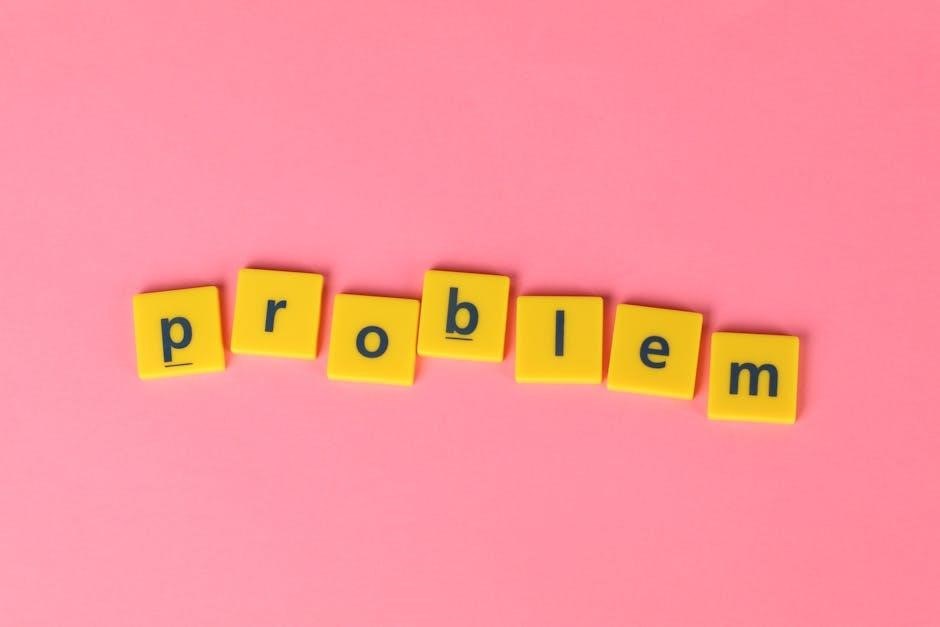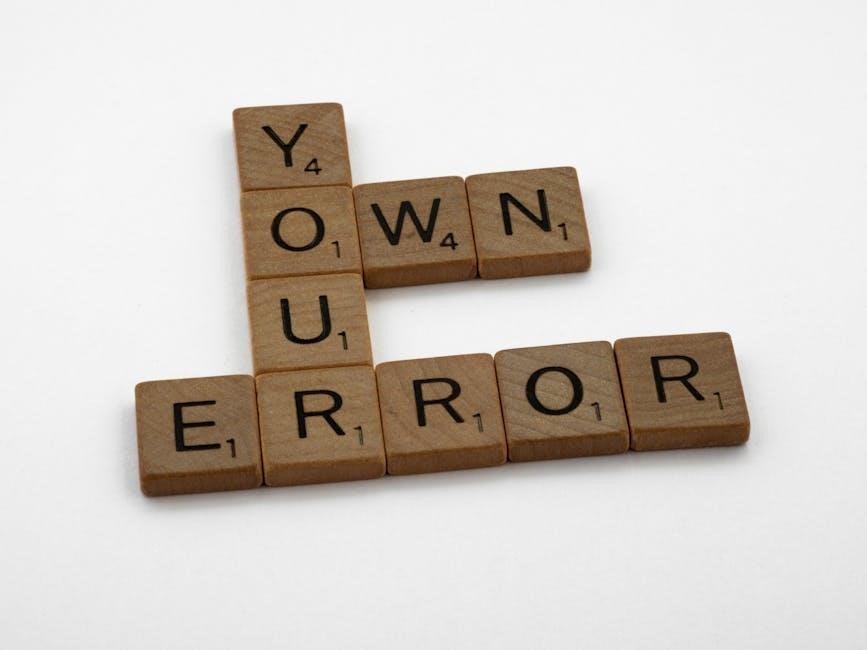
percentage word problems worksheets for grade 7 pdf
Percentage word problems are essential for developing proportional reasoning and real-world math skills. These problems involve finding a percentage of a number, percentage increase/decrease, and converting fractions or decimals to percentages. They help students understand practical applications like discounts, investments, and population changes, making them a fundamental part of the Grade 7 curriculum.
Importance of Practicing Percentage Word Problems
Practicing percentage word problems is crucial for improving math fluency and problem-solving skills. These exercises help students understand how percentages apply to real-life scenarios, such as discounts, investments, and population changes. Regular practice builds confidence in identifying parts of a whole, calculating increases or decreases, and converting between fractions, decimals, and percentages; Mastering these skills is essential for higher-level math and everyday decision-making, making percentage word problems a cornerstone of Grade 7 math education.
Key Skills Developed Through These Worksheets
Practicing with percentage word problems enhances critical thinking and mathematical fluency. Students develop skills in proportional reasoning, problem-solving, and applying percentages to real-world scenarios. These worksheets improve accuracy in calculations and the ability to interpret data; They also foster a deeper understanding of concepts like percentage increase/decrease and converting between fractions, decimals, and percentages. Regular practice builds confidence and prepares students for more complex math challenges in higher grades.

Sources for Free Percentage Word Problems Worksheets in PDF Format
Free PDF worksheets for Grade 7 percentage problems are available on educational websites like Cuemath and Mashup Math, offering comprehensive practice materials for enhanced learning.
Popular Websites Offering Grade 7 Worksheets
Websites like Cuemath and Mashup Math provide free PDF worksheets for Grade 7 percentage word problems. Cuemath offers comprehensive sheets covering basics, increases, decreases, and real-world applications. Mashup Math includes interactive problems tailored for different skill levels. These resources are designed to help students master percentage calculations and word problem-solving skills effectively.
How to Download and Use These Worksheets Effectively
To download worksheets, visit websites like Cuemath or Mashup Math, select the desired PDF files, and save them. Print or use digitally for practice. Start with basic problems, gradually moving to complex ones. Review answers to identify mistakes. Use a timer for timed practice to improve speed and accuracy. Regular practice reinforces concepts and builds confidence in solving percentage word problems effectively.

Key Topics Covered in Grade 7 Percentage Worksheets
Grade 7 worksheets cover calculating percentages of whole numbers, understanding percent increase and decrease, and converting fractions and decimals to percentages. These topics build foundational math skills.
Calculating Percentages of Whole Numbers
Calculating percentages of whole numbers is a core skill in Grade 7 math. Students learn to find a certain percentage of a whole number by converting the percentage to a decimal and multiplying. For example, 15% of 63 is calculated by multiplying 63 by 0.15. This skill is applied in various word problems, such as determining the number of items on sale or calculating discounts. Practice worksheets provide numerous exercises to master this fundamental concept, ensuring students can apply it confidently in real-world scenarios.
Understanding Percent Increase and Decrease
Understanding percent increase and decrease is a fundamental concept in Grade 7 math. Students learn to calculate how a number changes over time by comparing the original and new values. For example, if Diana invests $25,000 at 7% annual interest, the increase can be found using percentage calculations. Similarly, Janek’s height increasing by 10cm annually demonstrates a real-world application. Worksheets provide practical exercises to master these calculations, ensuring students grasp how percentages reflect growth or reduction in various scenarios.
Converting Fractions and Decimals to Percentages
Converting fractions and decimals to percentages is a key skill in Grade 7 math. Students learn to convert fractions like 1/4 to 25% and decimals like 0.375 to 37.5%. Worksheets provide exercises where students practice these conversions, such as finding the percentage of 15 out of 63 or determining what percent 62 is of 160. These problems build a strong foundation for solving more complex percentage word problems in real-world scenarios, like calculating discounts or understanding population percentages.

Common Types of Word Problems in These Worksheets
Worksheets feature single-step and multi-step problems, such as finding percentages of whole numbers, calculating increases/decreases, and real-world scenarios like sports team compositions or investment returns.
Single-Step Percentage Problems
Single-step percentage problems involve straightforward calculations, such as finding a percentage of a whole number or determining the percentage increase/decrease. These problems require basic understanding of percentage concepts and are designed to build foundational skills. Examples include calculating 15% of 63 or determining what number is 45% of 580. These problems are ideal for introducing students to percentage applications in simple, real-world scenarios, like discounts or population changes, and are widely available in practice sheets from sources like Cuemath or Math Worksheets.
Multi-Step Percentage Problems
Multi-step percentage problems require students to apply multiple skills, such as calculating percentages, converting between forms, and setting up equations. These problems often involve real-world scenarios like budgeting, investments, or population changes. For example, determining how much a budget increases after a percentage rise or calculating the final amount after successive percentage changes. These problems enhance critical thinking and problem-solving abilities, preparing students for complex mathematical challenges in higher grades. Worksheets from sources like Cuemath offer varied practice in these areas.
Real-World Applications of Percentage Problems
Percentage problems are vital in real-life situations, such as calculating discounts while shopping, understanding investment returns, or analyzing population growth. For instance, determining how much a television costs after a 20% discount or calculating the increase in student enrollment over a year. These applications help students see the practical relevance of math, making learning more engaging and meaningful. Worksheets from sources like Cuemath and Mashup Math offer scenarios that mirror everyday life, reinforcing the importance of percentage skills in real-world contexts.
Tips for Solving Percentage Word Problems
Identify the total and part, set up equations using percentages, and verify answers by reversing calculations. Practice regularly to build confidence and accuracy in solving problems.
Identifying the Total and the Part
Identifying the total and the part is crucial in percentage problems. The total is the whole amount, while the part is a portion of it. For example, if 21 out of 28 basketball players are 7th graders, the total is 28, and the part is 21. To find the percentage, divide the part by the total and multiply by 100. This step ensures accurate calculations and helps students understand how percentages represent parts of a whole in real-world scenarios.
Setting Up Equations for Percentage Problems
Setting up equations for percentage problems involves identifying the part, total, and percentage. Use the formula: (part/total) * 100 = percentage. For example, if 21 out of 28 basketball players are 7th graders, the equation is (21/28) * 100 = 75%. Always label the part and total to avoid mix-ups. This method ensures clarity and accuracy when solving word problems, helping students understand how percentages relate to real-world scenarios like team compositions or budget allocations.
Verifying Answers for Accuracy
Verifying answers ensures your solutions are correct. Always check calculations and logic. Plug numbers back into the original problem to confirm validity. For example, if 21 of 28 basketball players are 7th graders, verify by calculating 21/28 = 0.75, which is 75%. Use estimation to see if answers make sense. Properly round percentages to the nearest whole number or as instructed. This step prevents errors and builds confidence in problem-solving abilities.
Examples of Grade 7 Percentage Word Problems
Examples include calculating the percentage of 7th graders on a basketball team or determining investment returns. These problems often involve sports, shopping, and real-world financial scenarios.
Sample Problems Involving Sports Teams
Sports teams often feature in percentage word problems, making math relatable and engaging. For example, “A basketball team has 28 players, and 21 are 7th graders. What percent of the team are 7th graders?” Another problem might ask, “If a soccer team won 18 out of 25 games, what percentage of their games did they win?” These scenarios help students apply percentage skills to real-world sports contexts, making learning fun and practical.
Investment and Budgeting Scenarios
Investment and budgeting scenarios teach students to apply percentages to real-world financial decisions. For example, “Diana invests $25,000 at 7% annual interest. How much will she have after one year?” or “Ms. Jolla has a $1,000 budget for a TV costing $950. What percent of her budget does the TV cost?” These problems help students understand interest calculations, budget comparisons, and percentage-based financial planning, preparing them for practical money management and investment decisions in the future.
Population and Demographic Questions
Population and demographic questions involve calculating percentages to understand trends and distributions within groups. For example, “There are 220 students in Year 7, and 15% cycle to school. How many students cycle?” or “A town’s population increases by 10% annually. What will be the population in 5 years?” These problems help students analyze real-world data, such as urbanization rates or vaccination percentages, developing their ability to interpret and apply percentages to societal changes and demographic shifts effectively.

Common Mistakes to Avoid in Percentage Problems
Common errors include misinterpreting the total and part, incorrect conversions between percent and decimal, and neglecting to round answers appropriately. These mistakes can lead to inaccurate solutions.
Misinterpreting the Total and the Part
Misidentifying which number represents the total and which is the part is a frequent error. For instance, in problems like “15 is 25% of what number,” students often confuse the part and the whole. This misunderstanding leads to incorrect equations and wrong answers. Emphasizing clear problem analysis and labeling can help prevent such mistakes, ensuring students accurately determine which value corresponds to the total and which to the part before solving.
Incorrect Conversion Between Percent and Decimal
Converting between percentages and decimals is a common source of errors. Many students mistakenly divide by 100 instead of multiplying or vice versa. For example, 25% should be 0.25, but some may incorrectly write it as 0.0025. Regular practice with conversion exercises and reinforcing the concept that percentages are fractions of 100 can minimize these mistakes, ensuring accurate calculations in word problems involving percentage conversions.
Neglecting to Round Answers Appropriately
Many students overlook the need to round their answers to a reasonable number of decimal places. For instance, a percentage might be calculated as 33.333% instead of rounding to 33.33% or 33%. Failing to round can lead to unnecessarily complicated answers. Emphasizing the importance of rounding during practice helps students present clear and precise solutions, especially in real-world scenarios where exact decimals are often impractical.
Engaging Activities to Reinforce Learning
Organize group challenges where students solve percentage problems collaboratively, fostering teamwork and healthy competition. This interactive approach enhances problem-solving skills and makes learning engaging and fun.
Creating Personalized Word Problems
Creating personalized word problems allows students to connect with real-life scenarios, enhancing engagement and understanding. By incorporating topics like sports or shopping, learners can craft problems that reflect their interests, making percentage concepts more relatable. This approach not only boosts problem-solving skills but also encourages creative thinking, helping students see the practical relevance of percentages in everyday situations. Personalized problems make learning interactive and enjoyable, ensuring a deeper grasp of the material.
Group Challenges and Competitions
Group challenges and competitions are dynamic ways to engage students in percentage word problems. These activities encourage teamwork, problem-solving, and healthy competition. Students can work in pairs or teams to solve problems, fostering collaboration and communication. Competitions can also motivate students to improve their speed and accuracy. Teachers can create time-bound challenges or problem-solving races, making learning fun and interactive. Such activities not only enhance math skills but also build confidence and camaraderie among learners, making the learning process enjoyable and effective.
Interactive Games for Percentage Practice
Interactive games make percentage practice engaging and fun for Grade 7 students. Platforms like Kahoot! and online math simulations offer percentage-based games that test problem-solving skills. These games often feature real-world scenarios, such as calculating discounts or investment returns, to make learning relevant. Students can compete individually or in teams, improving their speed and accuracy. Games also provide immediate feedback, helping students identify areas for improvement. This interactive approach makes abstract concepts more tangible and enjoyable, fostering a deeper understanding of percentages.